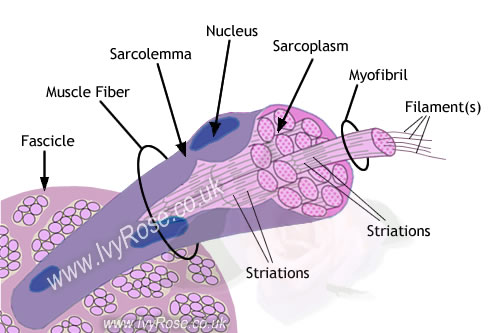
Myofibril
Myofibril is the name given to cylindrical structures that extend along the complete length of each muscle cell. Recall that "muscle cell" = "muscle fibre" = "muscle fiber" (Am.Sp.).
See the diagram below for further detail about the structure of myofibrils and their location within muscle cells.

Above: Diagram of the structure of a muscle fibre, indicating a single myofibril (top right)

Each myofibril consists of two types of protein filaments. They are thin filaments and thick filaments.
There are hundreds of myofibrils in each muscle fibre. Myofibrils line up with each other such that the Z-lines (formed from adjacent Z discs) of each sarcomere in one myofibril line up with the Z-lines of the sarcomeres in adjacent myofibrils.
This section consists of short summaries about the
structures that form the muscles of the body.
This list is not exhaustive but is intended to be appropriate for students
of A-Level Human Biology, ITEC courses in massage and related subjects,
and other courses in health sciences. For more general information about muscles see
the pages about:
This section is about the
anatomical structures of muscles.
- Anterior Muscles
- Posterior Muscles
- Facial Muscles
- Muscle Terminology (Definitions)
- 1. Structure of Muscle
- 2. Structure of Muscle Cells
- 3. Muscle Filaments
- 4. Sliding Filament Theory
- 5. Neuromuscular Junction
- 6. Actions at Neuromuscular Junction
- Types of Muscle Contractions
- Muscular Disorders
- Effects of exercise on muscles












